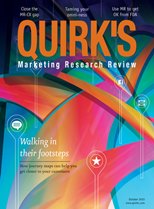Editor’s note: Pat Sabena is a consultant at Sabena Qualitative Research Services, Fairfield, Conn.
Qualitative research for health care companies, especially big pharma, has changed notably over the past decade. The business climate for health care is changing, along with the introduction and enforcement of new regulations. The following paragraphs discuss some of the major trends that are impacting qualitative research in the health care sector.
1. Change in pharma business model
Developing a drug through the traditional pipeline model is an expensive process. Many blockbuster drugs have already gone off patent, which enables generic competition to come in at a lower price.
To improve drug development portfolios, major pharma companies have resorted to an acquisition model. In this approach – to avoid the substantial investment required by the traditional pipeline model – smaller startup companies who have successfully developed compounds through positive Phase 3 clinical trial results (i.e., make-or-break studies that unequivocally prove safety and efficacy) are acquired by larger companies. This approach decreases or (in some cases) virtually eliminates the qualitative research that used to accompany the long pipeline stage where the brand team learns about the disease state and unmet needs of physicians, patients and caregivers.
2. Increased regulations and restrictions
Over the past several decades, as scientific understanding has improved, the FDA has become increasingly vigilant in monitoring safety data. As a result, many “black box warnings” have been reported, which undercut advertising and promotional spending (and qualitative research) for designated drugs.
Promotional spending toward physicians is now famously regulated, banning the boondoggles that physicians used to receive to travel to desirable destinations with their spouse to “learn” about a drug in between swimming and golf.
Rep activity has similarly declined, which makes pharmaceutical companies less likely to spend money on qualitative research to fine-tune any visual aid materials used by reps in physician visits and lunch-and-learns in physician offices. These materials were previously developed and refined in iterative qualitative research.
3. Layoffs of market researchers
Since 2010, many of the top 10 pharma companies have decimated whole departments of market research personnel in an effort to save costs (as part of the change from pipeline to acquisition models). Some have left a market research department in place only in categories where acquisition drugs are about to launch. This has vacated the trusted vendor relationships that market research executives once had with their qualitative suppliers.
4. “Sourcing” research vendors
Starting around 2005, so-called “sourcing” departments were installed with the aim to cut vendors (for example, one big-name pharmaceutical company went from 120 research vendors to 18 preferred supplier market research vendors, and ultimately down to four) by negotiating price-reduction deals for research.
Typically, 80 percent of suppliers had to be on this resulting approved supplier list, with only 20 percent discretion for outside vendors, further deterred by considerable and annoying paperwork on the part of the brand team. Price negotiating sessions were brutal and usually only big companies could survive this, typically by using on-staff junior personnel with senior supervisors. Big companies could afford to pay or handle the pressure to postpone the traditional big advance deposits for qualitative research (incentive fees, 50 percent facility fee, etc.), something sole proprietors or smaller qualitative companies find more difficult to manage.
5. Affordable Care Act
In anticipation of reduced reimbursement for patient care and procedures, many physicians (especially in primary care) have chosen to retire rather than maintain office staff, overhead and huge paperwork loads in a time of declining reimbursements.
Other physicians have become hospitalists, transferring their jobs to working on salary at hospitals to provide care for hospitalized patients, thereby eradicating their own staffing.
Insurance formularies have also tightened their disbursements toward the cheapest drugs. In this environment, fewer physicians have meaningful roles in what version of a drug class they prescribe, which further diminishes any point to market to (or research) them.
6. Electronic medical records: Requirements and HIPAA compliance
Another development is the mandate for electronic medical records (EMR). Although the government subsidizes this program to an extent, there is no universal or standardized software to accomplish this transfer of data from paper to electronic.
Adding further complication, an individual physician may choose one software package, whereas his hospital and other doctors (and even departments within a single hospital) have selected different software. Few of these platforms are able to interface with the other.
These disconnects, along with HIPAA Compliance (the Health Insurance Portability and Accountability Act of 1996), make it increasingly difficult for pharmaceutical companies to know which doctors are or are not prescribing their brand of drugs. This information had long been available and it was delivered as a confidential list to qualitative researchers to enable them to recruit only high or moderate prescribers of a specific drug instead of low or non-prescribers.
7. Adverse event (AE) reporting
Another restriction that has affected the quantity and quality of qualitative research is the increasingly imposed restrictions and consequences of mandated adverse event reporting.
Qualitative research often uncovers specific complaints or cases of side effects of specific medications in conversation with physicians and/or patients. Any mention of an adverse event during qualitative research requires several immediate follow-up questions in the midst of interviewing, plus immediate 24-hour vendor reporting by fax or phone to the adverse event reporting department. Because of this, the marketing department tries to avoid any specific feedback about adverse events, via formal training of any vendor involved in research and by intense scrutiny by pharma legal of any discussion guide. This is one reason why some pharma companies limit the number of vendors that can be used.
Considering these trends, it is evident that qualitative research in the health care sector is changing. While the demand for research has reduced, it is still there for those who understand the evolving needs of these companies. As the effects of new regulations and changing business models stabilize, it will be interesting to see how the needs for qualitative research will play out.
